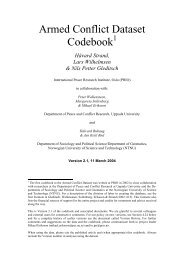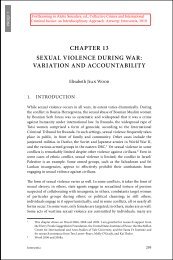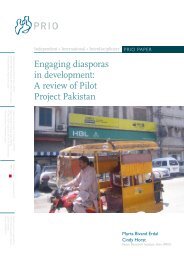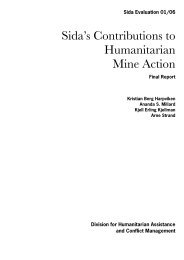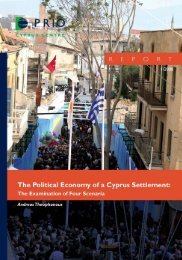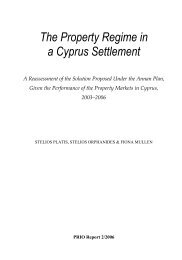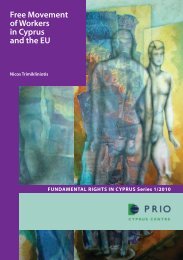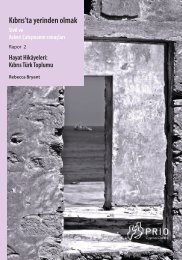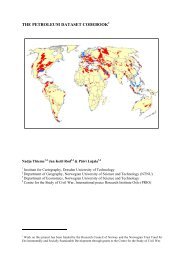Peacemaking Is a Risky Business - PRIO
Peacemaking Is a Risky Business - PRIO
Peacemaking Is a Risky Business - PRIO
Create successful ePaper yourself
Turn your PDF publications into a flip-book with our unique Google optimized e-Paper software.
Implementing Peace217for Jewish settlers only, were carving the West Bank and Gaza into bits and pieces,making the prospect of future Palestinian statehood more remote than ever. 313The situation was no better on the <strong>Is</strong>raeli side, where the most bitter and most poisonouscriticism came from the <strong>Is</strong>raeli right, the settler movement and the religious nationalistcamp. All of their fears had been confirmed with the signing of the InterimAgreement. The whole Oslo process was a disaster in their eyes, leading to what theyregarded as a Palestinization of Judea and Samaria. On 5 October 1995, Prime MinisterRabin presented the agreement and the thinking behind it to the Knesset. The InterimAgreement won the smallest possible majority: 61 members of the Knesset were infavour of it, while 59 voted against. The same day, tens of thousands of demonstratorsgathered in Jerusalem to show their disgust and disapproval. The leader of the LikudParty, Binyamin Netanyahu, took part in this demonstration, calling the agreement an‘act of surrender’ and a ‘danger to the existence of the State of <strong>Is</strong>rael’. 314 He arguedthat ‘[t]he Jewish majority of the State of <strong>Is</strong>rael did not approve this agreement. Weshall fight it and we shall bring down the government.... Rabin is causing a nationalhumiliation by accepting the dictates of the terrorist Arafat’. 315 Leaflets depicting Rabinin an SS uniform were distributed. ‘Rabin is a Nazi’, shouted the crowd. A numberof Holocaust images were used, and Rabin was portrayed as a ‘traitor’, a ‘murderer’, a‘Nazi’ and an ‘illegal prime minister’. 316 To his advisers, Rabin made it clear that hewould continue the peace enterprise he had started, despite the turmoil in the streets,the threats and the incitements. This determination was to cost him his life. 317On 4 November 1995, Rabin attended a huge peace rally in Tel Aviv, with a crowdof some 150,000 people in attendance. It was the largest mass demonstration that TelAviv had witnessed since the signing of the Oslo Agreement in 1993. Yigal Amir, afanatical 25-year-old law student from Bar-Ilan University, where numerous rightwingand religious extremists were enrolled as students, assassinated the prime minister.Despite the vicious criticism and the ominous warnings that had been voiced, noone had really imagined that the killing of <strong>Is</strong>rael’s leader would or could actually becarried out. The passion and the hate of the extreme religious and nationalist right hadclearly been underestimated. The Oslo process had lost one of its crucial players. 318The murder revealed the deep divisions inside <strong>Is</strong>rael in relation to peace with thePalestinians. While the <strong>Is</strong>raeli left and the Labour Party wanted some sort of compromisewith the Palestinians, the <strong>Is</strong>raeli right – and in particular the extreme nationalistreligious camp – saw the Jewish people as the rightful owners of the Promised Land,the Greater <strong>Is</strong>rael that included all of the Occupied Territories. There was no possibilityof compromise in their minds. The Labour Party supported the building of settlementsbecause they wanted to increase the proportion of land held by <strong>Is</strong>raelis. The parties on313 Shlaim 2001, p. 530.314 Savir 1998, p. 248.315 Shlaim 2001, p. 551.316 Savir 1998, p. 248.317 Shlaim 2001, pp. 546–551; Savir 1998, pp. 247–264; Quandt 2000, pp. 336–338.318 Same references as above.



